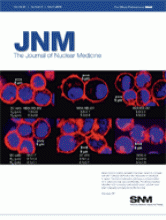TO THE EDITOR: Zhernosekov et al. (1) have published a method for processing generator eluate from 68Ge/68Ga generators for medical applications, and currently this method is widely used for clinical preparations, especially of 68Ga-labeled 1,4,7,10-tetraazacyclododecane-N,N′,N″,N‴-tetraacetic acid (DOTA)-d-Phe1,Tyr3-octreotide (DOTATOC) and other somatostatin analogs. The method is based on preconcentration of 68Ga ions in the eluate on a cation exchanger followed by selective washing and subsequent elution using hydrochloric acid/acetone solutions. This method removes unwanted metallic impurities and reduces the volume, as is especially suitable for radiolabeling of small peptides such as DOTATOC. We investigated this method in an attempt towards developing a fully automated system. During our validation steps of this method, we observed an unknown peak in the ultraviolet trace (220 nm) of the high-performance liquid chromatograms of 68Ga-labeled peptides increasing over time with prolonged storage of the hydrochloric acid/acetone solutions. The peak eluted closely to DOTATOC or DOTA-d-Phe1,Tyr3-octreotate used for radiolabeling when analyzed under standard acetonitrile/0.1% trifluoroacetic acid/water gradient high-performance liquid chromatography (HPLC) conditions. By means of gas chromatography mass spectrometry, we finally identified the peak to be 4-methyl-3-penten-2-on (mesityloxide), a condensation product of acetone. Apparently, this impurity and the 68Ga-labeled peptide have comparable properties on the reversed-phase (C-18) material used both for purification after synthesis and for quality control by HPLC. Because of the high boiling point (129°C) of this compound, the peak was detected even when prolonged heating was applied, and column purification failed to remove it. We could show that the amount of mesityloxide formed is dependent on storage time and storage conditions of the hydrochloric acid/acetone stock solutions. Storage at room temperature and exposure to light resulted in formation of milligram amounts, and up to 0.7 mg was detected in a final volume corresponding to a patient preparation. If the mixtures were prepared freshly or stored with protection from light at −20°C, this amount was below 10 μg. Mesityloxide is not a highly toxic compound, and median lethal dose in rats (1.12 mg/kg (2)) is comparable to that of acetone. However, as no limits for parenteral preparations are available in relevant documents such as the U.S. Pharmacopeia, the amount should be limited; a reasonably achievable limit seems to be 50 μg per maximum volume injected. We strongly recommend all users of this method to include into their quality control protocols a quantification of this impurity by means of HPLC–ultraviolet detection or gas chromatography. Additionally, careful validation of preparation and storage of hydrochloric acid/acetone solutions has to be performed. Alternative preparation methods avoiding the use of hydrochloric acid/acetone mixtures have been described (3,4) and may also be envisaged.
Footnotes
-
COPYRIGHT © 2010 by the Society of Nuclear Medicine, Inc.







